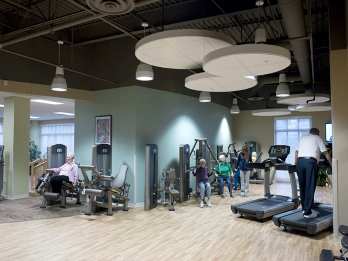 Picture this: You are 78 years old touring a senior living community with the marketing and sales coordinator. They take you to the ground floor or basement of the building and they flip on the lights of the uninhabited fitness center. It has painted cinderblock walls, fluorescent lights, no windows, and a hodgepodge of equipment. It feels deserted and you wonder how active the community is.
Picture this: You are 78 years old touring a senior living community with the marketing and sales coordinator. They take you to the ground floor or basement of the building and they flip on the lights of the uninhabited fitness center. It has painted cinderblock walls, fluorescent lights, no windows, and a hodgepodge of equipment. It feels deserted and you wonder how active the community is.
You then tour a neighboring community and you see the fitness center on the main floor, with sleek and contemporary equipment, dedicated staff leading residents through a workout, light pouring in through the windows, and more residents passing by in the hallway just having left the bistro next door from an afternoon coffee talk.
These two environments paint highly different images of a community and the residents’ experience engaging in an active lifestyle. While the ground-floor space is quiet and functional for exercise, the main-floor fitness center conveys vibrancy and a sense of community. It is a space to inspire residents to be active and champion a healthy lifestyle. The purpose of my comparison is not to bash ground-floor fitness centers, however; we have developed highly successful fitness programs in this exact environment. But if you have the means to move your fitness center to a more central location, it’s something to consider.
Moving the Fitness Center out of the Basement
Over the years, we have witnessed more and more clients bringing their fitness centers out of the basement or tucked-away spaces and positioning the fitness center as part of the central hub of activity alongside their dining venues and auditoriums. It isn’t just another room where people who like to exercise can go. It is in the forefront and inspires residents to go exercise!
This type of renovation can be easier said than done in finding the space, resources, and more to make this kind of transition happen. Even if you don’t have the resources at the moment to renovate or relocate your fitness center, there is plenty that communities can do to cultivate that inspiring and engaging environment. After all, we’ve seen some of the most beautiful, state-of-the-art fitness centers go underutilized without proper staffing support for residents.
Liven Up Your Fitness Space
Consider these three tips to liven up any fitness space.
- Staffing, staffing, staffing! Of course I’m going to beat this drum, but we’ve watched underutilized fitness centers from 800 square feet to 2,500 square feet blossom into lively and inviting spaces simply by adding qualified fitness staffing who build relationships with the residents and offer quality programs and services. Give your fitness center a personal connection and draw for residents.
- Give it a facelift: It’s always amazing what a coat of paint and fresh flooring can do for a space. If your space is lacking windows, make sure plenty of lighting is available and choose a light paint color.
- Update the small supplies: Sometimes the small supplies of dumbbells, stability balls, ankle weights, and so on can overrun a space and make it feel cluttered without proper storage solutions. Consider how these items are housed and consider making small investments in storage options or replacing items. A dumbbell rack with uniform weights, for example, is much sleeker than mismatched styles and colors you’ve accumulated over time.
If you are looking to give your space an upgrade or interested in more information on qualified staffing to champion your fitness program, contact the experts at NIFS.


.jpg?width=521&name=GettyImages-929610028%20(1).jpg) I’m Too Old
I’m Too Old
.jpg?width=429&name=GettyImages-185211535%20(1).jpg) Tell me if this has ever happened to you: You are fast asleep in your warm, comfy bed. In the middle of that perfect sleep, you suddenly hear the telephone ringing. So you open your eyes, sit up, and slide your feet into your slippers. At this point, you are in a rush because you are now thinking that it could be an emergency. You take a few steps as quickly as you can to get to the phone, which happens to be all the way across the room. Suddenly, the front of your slipper nicks the carpet and you feel yourself going down and fast.
Tell me if this has ever happened to you: You are fast asleep in your warm, comfy bed. In the middle of that perfect sleep, you suddenly hear the telephone ringing. So you open your eyes, sit up, and slide your feet into your slippers. At this point, you are in a rush because you are now thinking that it could be an emergency. You take a few steps as quickly as you can to get to the phone, which happens to be all the way across the room. Suddenly, the front of your slipper nicks the carpet and you feel yourself going down and fast.
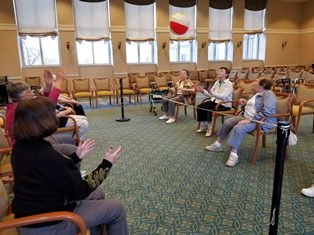

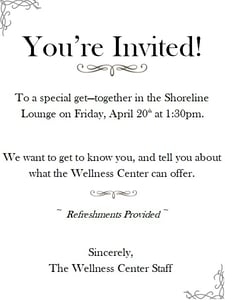




 For years, fitness professionals have been trained to use Body Mass Index (BMI) as a prescreening tool when individuals join a fitness program. It was part of the recommendations by the
For years, fitness professionals have been trained to use Body Mass Index (BMI) as a prescreening tool when individuals join a fitness program. It was part of the recommendations by the 
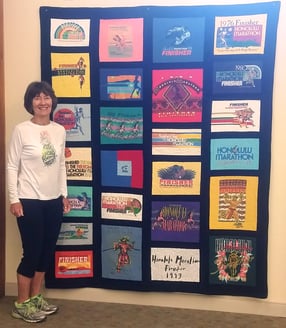
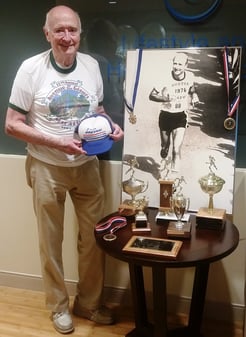 Shortly after Dan graduated from MIT, he married the love of his life, Portia, and they moved to Southern California where he began taking classes at USC and started work at the Hughes Research Laboratory. He's had quite a career - not only did he play
Shortly after Dan graduated from MIT, he married the love of his life, Portia, and they moved to Southern California where he began taking classes at USC and started work at the Hughes Research Laboratory. He's had quite a career - not only did he play 

